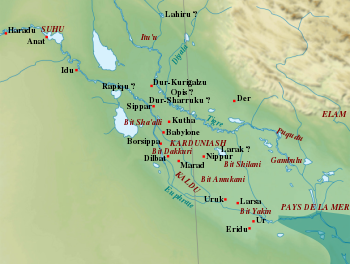
Back Galdeërs Afrikaans كلدو Arabic ܟܠܕܝܐ ܥܬܝܩܐ ARC Caldea AST Xaldeylər Azerbaijani کلده AZB Халдейҙар Bashkir Халдзеі Byelorussian Халдейска династия Bulgarian Caldea Catalan

Chaldea[1] (/kælˈdiːə/) was a small country that existed between the late 10th or early 9th and mid-6th centuries BC, after which the country and its people were absorbed and assimilated into the indigenous population of Babylonia.[2] Semitic-speaking, it was located in the marshy land of the far southeastern corner of Mesopotamia and briefly came to rule Babylon. The Hebrew Bible uses the term כשדים (Kaśdim) and this is translated as Chaldaeans in the Greek Old Testament, although there is some dispute as to whether Kasdim in fact means Chaldean or refers to the south Mesopotamian Kaldu.[citation needed]
During a period of weakness in the East Semitic-speaking kingdom of Babylonia, new tribes of West Semitic-speaking migrants[3] arrived in the region from the Levant between the 11th and 9th centuries BC. The earliest waves consisted of Suteans and Arameans, followed a century or so later by the Kaldu, a group who became known later as the Chaldeans or the Chaldees. These migrations did not affect the powerful kingdom and empire of Assyria in Upper Mesopotamia, which repelled these incursions.
These nomadic Chaldeans settled in the far southeastern portion of Babylonia, chiefly on the left bank of the Euphrates. Though for a short time the name commonly referred to the whole of southern Mesopotamia in Hebraic literature, this was a geographical and historical misnomer as Chaldea proper was in fact only the plain in the far southeast formed by the deposits of the Euphrates and the Tigris, extending about 640 kilometres (400 mi) along the course of these rivers and averaging about 160 km (100 mi) in width. There were several kings of Chaldean origins who ruled Babylonia.[4]: 178 From 626 BC to 539 BC, a ruling family referred to as the Chaldean dynasty, named after their possible Chaldean origin,[4]: 4 ruled the kingdom at its height under the Neo-Babylonian Empire, although the final ruler of this empire, Nabonidus (556–539 BC) (and his son and regent Belshazzar) was a usurper of Assyrian ancestry.
- ^ Sayce 1878, p. 372.
- ^ Roux 1992, p. 281.
- ^ Nordhoff, Sebastian; Hammarström, Harald; Forkel, Robert; Haspelmath, Martin, eds. (2013). "West Semitic". Glottolog 2.2. Leipzig: Max Planck Institute for Evolutionary Anthropology.
- ^ a b Beaulieu, Paul-Alain (2018). A History of Babylon, 2200 BC – AD 75. Hoboken: John Wiley & Sons. ISBN 978-1405188999.